Shadoks Approach to Knapsack Polygonal Packing (CG Challenge)
Authors
Guilherme D. da Fonseca  ,
Yan Gerard
,
Yan Gerard 
-
Part of:
Volume:
40th International Symposium on Computational Geometry (SoCG 2024)
Part of: Series: Leibniz International Proceedings in Informatics (LIPIcs)
Part of: Conference: Symposium on Computational Geometry (SoCG) - License:
 Creative Commons Attribution 4.0 International license
Creative Commons Attribution 4.0 International license
- Publication Date: 2024-06-06
File

PDF
LIPIcs.SoCG.2024.84.pdf
- Filesize: 2.14 MB
- 9 pages
Document Identifiers
Related Versions
- Full Version https://arxiv.org/abs/2403.20123
Subject Classification
ACM Subject Classification
- Theory of computation → Computational geometry
Keywords
- Packing
- polygons
- heuristics
- integer programming
- computational geometry
Metrics
- Access Statistics
-
Total Accesses (updated on a weekly basis)
0PDF Downloads0Metadata Views
Abstract
We describe the heuristics used by the Shadoks team in the CG:SHOP 2024 Challenge. Each instance consists of a convex polygon called container and a multiset of items, where each item is a simple polygon and has an associated value. The goal is to pack some of the items inside the container using translations, in order to maximize the sum of their values. Our strategy consists of obtaining good initial solutions and improving them with local search. To obtain the initial solutions we used integer programming and a carefully designed greedy approach.
Cite As Get BibTex
Guilherme D. da Fonseca and Yan Gerard. Shadoks Approach to Knapsack Polygonal Packing (CG Challenge). In 40th International Symposium on Computational Geometry (SoCG 2024). Leibniz International Proceedings in Informatics (LIPIcs), Volume 293, pp. 84:1-84:9, Schloss Dagstuhl – Leibniz-Zentrum für Informatik (2024)
https://doi.org/10.4230/LIPIcs.SoCG.2024.84
BibTex
@InProceedings{dafonseca_et_al:LIPIcs.SoCG.2024.84,
author = {da Fonseca, Guilherme D. and Gerard, Yan},
title = {{Shadoks Approach to Knapsack Polygonal Packing}},
booktitle = {40th International Symposium on Computational Geometry (SoCG 2024)},
pages = {84:1--84:9},
series = {Leibniz International Proceedings in Informatics (LIPIcs)},
ISBN = {978-3-95977-316-4},
ISSN = {1868-8969},
year = {2024},
volume = {293},
editor = {Mulzer, Wolfgang and Phillips, Jeff M.},
publisher = {Schloss Dagstuhl -- Leibniz-Zentrum f{\"u}r Informatik},
address = {Dagstuhl, Germany},
URL = {https://drops.dagstuhl.de/entities/document/10.4230/LIPIcs.SoCG.2024.84},
URN = {urn:nbn:de:0030-drops-200293},
doi = {10.4230/LIPIcs.SoCG.2024.84},
annote = {Keywords: Packing, polygons, heuristics, integer programming, computational geometry}
}
Author Details
Funding
Work supported by the French ANR PRC grant ADDS (ANR-19-CE48-0005).
Acknowledgements
We would like to thank the Challenge organizers and other competitors for their time, feedback, and making this whole event possible. We would like to thank Hélène Toussaint, Raphaël Amato, Boris Lonjon, and William Guyot-Lénat from LIMOS, as well as the Qarma and TALEP teams and Manuel Bertrand from LIS, who continue to make the computational resources of the LIMOS and LIS clusters available to our research. We would also like to thank Aldo Gonzalez-Lorenzo and the undergraduate students Aymeric Beck, Houssam Boufarachan, Marine Izoulet, and Carla Scardigli for coding viewers for the solutions.
Supplementary Materials
-
Software (Source Code)
https://github.com/gfonsecabr/shadoks-CGSHOP2024
browse
 archived version
archived version
References
- Alkan Atak, Kevin Buchin, Mart Hagedoorn, Jona Heinrichs, Karsten Hogreve, Guangping Li, and Patrick Pawelczyk. Computing maximum polygonal packings in convex polygons using best-fit, genetic algorithms and ilps. In Symposium on Computational Geometry (SoCG), volume 293 of LIPIcs, pages 83:1-83:9, 2024. URL: https://doi.org/10.4230/LIPIcs.SoCG.2024.83.
-
IBM ILOG CPLEX. V22.1: User’s manual for CPLEX. International Business Machines Corporation, 2023.

- Sándor P. Fekete, Phillip Keldenich, Dominik Krupke, and Stefan Schirra. Maximum polygon packing: The cg:shop challenge 2024, 2024. URL: https://arxiv.org/abs/2403.16203.
- Martin Held. Priority-driven nesting of irregular polygonal shapes within a convex polygonal container based on a hierarchical integer grid. In Symposium on Computational Geometry (SoCG), volume 293 of LIPIcs, pages 85:1-85:6, 2024. URL: https://doi.org/10.4230/LIPIcs.SoCG.2024.85.
- Canhui Luo, Zhouxing Su, and Zhipeng Lü. A general heuristic approach for maximum polygon packing. In Symposium on Computational Geometry (SoCG), volume 293 of LIPIcs, pages 86:1-86:9, 2024. URL: https://doi.org/10.4230/LIPIcs.SoCG.2024.86.
